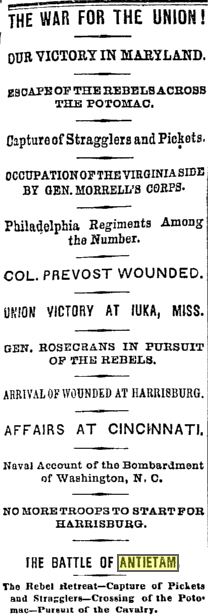Reports from the Antietam Battlefield
Posted By Norman Gasbarro on June 7, 2012
Excerpts from the Philadelphia Inquirer report of 22 September 1862:
THE WAR FOR THE UNION!
OUR VICTORY IN MARYLAND.
ESCAPE OF THE REBELS ACROSS THE POTOMAC.
Capture of Stragglers and Pickets.
OCCUPATION OF THE VIRGINIA SIDE
BY GEN. MORRELL’S CORPS
Philadelphia Regiments Among the Number
COL. PREVOST WOUNDED….
ARRIVAL OF WOUNDED AT HARRISBURG….
THE BATTLE OF ANTIETAM
The Rebel Retreat – Capture of Pickets and Stragglers – Crossing of the Potomac – Pursuit of the Cavalry
The retreat of an army as large as that of the Rebels, in the face of one like that of our own, was certainly creditable to its commanders, especially when it is considered that they met with slight loss while it was being contemplated. One thing, however, was in their favor, which was that they had the Antietam in their front, about half the length of their line, over which our troops could only cross at one point.
It was at this bridge that [our] cavalry made such a splendid dash across in the face of a fire-storm from several batteries, planted so as to sweep it from different pots, and which rained a perfect shower of shell upon it while our troops were crossing, most of which, fortunately, did not explode. As soon as the cavalry crossed, they were followed by regulars, in support of three batteries….
Some of the most desperate fighting ever recorded in history took place on this field. In passing over the ground to-day, the evidence was manifest. Where the most deadly contests occurred, the dead were lying thick, and in rows, where they had fallen. On the enemy’s centre three lines of battle had been formed from a point west of the Hagerstown Turnpike across the road and several fields… or about a half a mile, and these lines were almost as distinct as when the living mass still formed them.
The dead were lying so close as to be nearly in reach of one another’s hands along the entire distance, while in many places they lay one upon another….
The enemy’s loss on this part of the field was at least two to one, and many are of the opinion that it would average the same all over the battle-ground.
This is accounted for by the fact that our men fire high, while the rebels seem to be particularly instructed to fire low. The prisoners say they always like to meet a regiment of Zouaves with red trousers, as they serve as distinctive marks. In evidence of this, the casualties of the 14th Brooklyn Infantry and the 5th New York Infantry Regiments, three-fourths of the casualties among them in every battle being in the lower limbs….
In the haste of the retreat the enemy left about five hundred of their wounded at houses and barns, where they had established hospitals, and very few of their dead were buried, excepting officers, their graves being found in the corn fields in the rear of their lines. A large number of their wounded were brought off the field in our ambulances, and cared for by our surgeons. At one of their hospitals some of our wounded had been taken, an, the officer in charge having forgotten to parole them, a brigadier general returned on Friday morning to do so, and had just gone a few minutes when a cavalry soldier appeared, who gave chase, firing the contents of his revolver at the flying Rebel, but without effect.
An incident is related of a boy belonging to the 9th New York Infantry, but whose name could not be ascertained, who stood in front of his regiment while it engaged the enemy, at short range, in which position he fired all his cartridges, and stooping down took his dead comrade’s cartridge box and fired the entire contents, in all ninety-five rounds, not receiving a scratch the whole time, notwithstanding the ground was covered with the dead and wounded all around him. The regiment was ordered to charge a rifle pit where the Rebels were concealed, and our young hero here was the first who entered it – the enemy flying at the approach of the bayonet.
The loss of the Rebels at the battle was heavy and evidently exceeded ours. A wounded soldier of the 2nd North Carolina Infantry said his regiment left Richmond a month ago, seven hundred strong, and on Thursday morning could only muster two hundred and twenty….
For previous posts on the Battle of Antietam, click here. News articles are from the on-line resources of the Free Library of Philadelphia.
 ;
;



Comments